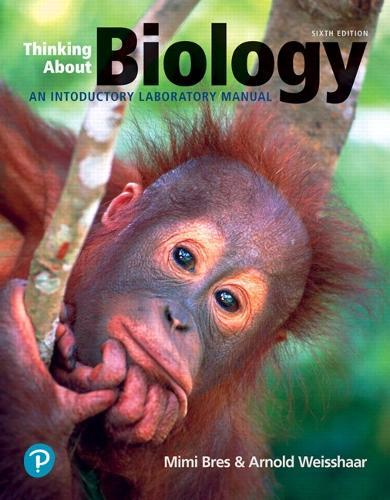Overview
For one-semester, non-majors introductory biology laboratory courses Thinking About Biology: An Introductory Lab Manual offers an extensively class-tested approach to the introductory biology laboratory course. The manual enables students to see how scientists work to solve problems through scientific investigation by asking questions and answering them through observations and conducting experiments. This lab manual helps students gain practical experience to better understand lecture concepts, acquire the basic knowledge needed to make informed decisions about biological questions in everyday life, develop the problem-solving skills that will lead to success in school and a competitive job market, and learn to work effectively and productively as a member of a team. The 6th Edition features new and revised activities based on feedback from students and faculty.
Full Product Details
Author: Mimi Bres ,
Arnold Weisshaar
Publisher: Pearson Education (US)
Imprint: Pearson
Edition: 6th edition
Dimensions:
Width: 10.00cm
, Height: 10.00cm
, Length: 10.00cm
Weight: 0.100kg
ISBN: 9780134765624
ISBN 10: 0134765621
Pages: 472
Publication Date: 21 February 2018
Audience:
College/higher education
,
Tertiary & Higher Education
Format: Paperback
Publisher's Status: Active
Availability: Available To Order

We have confirmation that this item is in stock with the supplier. It will be ordered in for you and dispatched immediately.
Author Information
Mimi Bres, Ph.D. Professor and Arnold Weisshaar, Professor Emeritus, Department of Biological Sciences, Prince George’s Community College in Largo, Maryland. Mimi Bres, Ph.D, tenured Professor, Prince George's Community College, Largo, Maryland Dr. Bres has over 20 years experience with the development of curriculum materials designed to stimulate interest in science and to improve critical thinking skills. Of particular note is her recent work developing an interactive web and video-based curriculum, including a virtual field component, to teach environmental concepts without the need for student travel. Dr. Bres has also worked as a consultant to corporations and government agencies. She served as team leader and developer for the Environmental Protection Agency's Environmental Education Library, a series of video curriculum modules for college and high school classes which highlight hazardous chemical response and remediation projects carried out under the SuperFund Program. Dr. Bres has also served as a consultant to the Prince George's County School District in an initiative to improve the delivery of high school science courses. As a result of her expertise, Dr. Bres has been an invited speaker at a number of national meetings and seminars. Her work on the use of cooperative learning techniques has improved both student performance and interest in science. Dr. Bres' excellence in science education has been recognized by her selection for the National Award for Innovative Excellence in Teaching, Learning, and Technology by the Center for the Advancement of Teaching and Learning, the Teaching Recognition Award by the University of Maryland University College, and Outstanding Faculty Mentor of the Year by the science division students of Prince George's Community College. Recent books include: Thinking About Biology, 4th edition (a laboratory manual for general biology), Hands-On Biology: Laboratories for Distance Learning (a laboratory manual for online general biology courses), Human Biology: Condensed, 7th edition (a simplified lecture study guide that incorporates problem solving activities into the curriculum), and Cooperative Learning: Making Connections in General Biology (a collection of cooperative activities). Arnold Weisshaar, Professor Emeritus, Prince George's Community College, Largo, Maryland Professor Weisshaar has had a distinguished 36 year career in higher education. During his career, he has been the spearhead of several initiatives to improve science education and expand the College's program offerings. In the classroom, Professor Weisshaar has worked extensively with underprepared students of diverse social and ethnic backgrounds. In an attempt to improve instructional delivery, he has co-authored a variety of support materials for students. Recent publications include laboratory manuals for general biology, including: Thinking About Biology, 4th edition and Hands-On Biology: Laboratories for Distance Learning and a simplified lecture study guide that incorporates problem solving activities into the curriculum (Human Biology: Condensed, 7th edition). In the course of developing the above-mentioned materials, Professor Weisshaar became interested in cooperative learning strategies as a tool for




